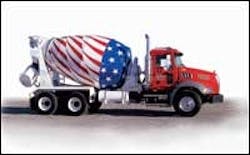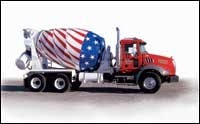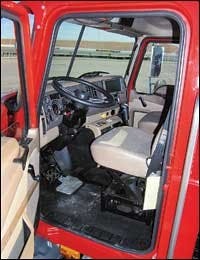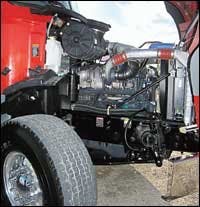Mack's Axle Back Takes Turns Tightly
Since the late 1990s, designers and engineers at Mack Trucks have been busy fashioning the replacements for popular and long-running vocational models with the old R-model cab. The result is the modern and comfortable Granite series, first unveiled in 2002 with forward-set steer axles usable where weight laws favor wide-spread axle settings. Now Mack loyalists in axle-weight states, mainly in the East, Midwest and South, have a third model to pick from, the Granite Axle Back.
Shown off at the World of Concrete show in January, the AB has its steer axle set 50.5 inches behind the bumper, or 20.5 inches more than the previously introduced Granite and Granite Bridge Formula. That somewhat radical setting is what gives the new Axle Back model its name and its function. Also standard on the new truck is a higher-capacity Cornerstone frame with taller main rails than those used on the other models.
The Granite Axle Back can take high up-front loads by virtue of beefy axles and taper- or multileaf suspensions rated at up to 23,000 pounds. It claims exceptional maneuverability because of wheel cuts made as tight as wide wheels and tires allow. Those characteristics resulted in a firm ride and exceptional maneuverability in the mixer chassis I drove during the AB's introduction at the Las Vegas Speedway.
With its Beck Industrial mixer drum carrying about 8 tons of gravel, the truck scaled at 47,800 pounds — better than 10 tons under its rated gross weight — so the 10-wheeler's front end bounced a bit on its stiff springs. And with plenty of room on the parking lot, I could easily execute some short-radius circles to simulate turn-arounds at jobsites. The truck was quite nimble.
Drivers among the press corps were limited to coned-in courses on the lot; although I ventured outside the cones to do the yo-yos, there wasn't enough room in designated straightaways to get the mixer past about 45 mph in top gear. So I couldn't get a feel for the claimed 365 horsepower that the 12-liter AMI-335 claims to make at 1,700 to 1,900 rpm. AMI means Application-specific, Maxidyne, Internal EGR, features which comprise a story in itself (which we did for CE's April '03 issue).
This iteration of the wide-revving Maxidyne concept uses a simple internal exhaust-gas recirculation system to reduce oxides of nitrogen (NOx). This is unique among American-made diesels, most of which have more complex cooled, external EGR. But to breathe properly, this version needs higher revs than previous Maxidynes, so its operating range is several hundred rpm higher. The rev range of the AMI Maxidyne is narrower, too, and it needs at least one extra transmission gear than the five-speed used so often in Maxidynes going back to the 1960s.
In this truck there were more than enough ratios available with an 11-speed Eaton Fuller "LL," basically a nine-speed with a low-low range for starting on upgrades with heavy loads or creeping around jobsites. If you use all forward gears, they add up to 11; this tranny shifted easily and had a nice, solid feel to the lever.
This vehicle was produced for a patriotic customer (check the starred-and-striped drum) in Texas. The Lone Star State's weight law allows as much as 46,000 pounds on the tandem and 23,000 on the steer axle, which allows a mixer to carry 10.5 yards of concrete on the three axles, according to the guy who sold this truck, Clint Campbell, sales manager at Dallas Mack Truck Sales. Those generous limits apply only to mixer and trash trucks; those industries evidently had convincing lobbyists working in the state capitol, he observed.
Accordingly, mixers ordered for the customer, American Concrete in Weatherford, get 23,000-pound front axles, Campbell said. Somehow this chassis wound up with a 20,000-pound front. Its tandem is like the others, though — 46,000-pound Meritor axles on a Hendrickson Haul Maxx suspension. As we climbed over a row of dirt moguls on an artificial off-road course, the rear running gear clunked a lot — not surprising, given the long stretching required to allow the axles' ends to articulate.
Twin-steer front axles are also available on the Granite Axle Back and I briefly drove one of those, too. Its front end hopped a bit on smooth pavement but it moved more smoothly over the moguls. Weight laws in several Canadian provinces encourage twin-steer fronts, and some stateside operators are beginning to use them because they float the load better over soft ground and are more stable than mixers with single steers and multiple lift axles.
As with previous Granites, this Axle Back's steel cab is based on the highway-service CH's, but is stoutly reinforced to take the stresses found while running off-road. It's the strongest cab Mack has ever built, says Steve Ginter, the vocational segment product manager who answered my questions during this drive. The instrument panel and interior trim are similar to a CH's, too, with a pleasant but no-nonsense ambience that makes a guy want to work — or at least you hope so if you're his boss.
The Axle Back's bumper-to-back-of-cab measurement is 112 inches, compared to 108 inches on the other Granites. Those numbers assume a bumper that's almost flush against the nose, as on this truck; sometimes the bumper's set well forward of the nose to accommodate a front-drive PTO, a snow-plow mount or transmission cooler. To clear any such stuff, the Granite's grill remains vertical as its fiberglass hood tilts.
See those big, grey fender flares? They're made of a plastic that flexes without damage if one hits something. The other Granites have plastic-tipped fenders, too, but these are much wider, almost looking like the flares on a Nissan Frontier pickup.
Projector-beam headlamps are the only ones available on the Axle Back for now; simpler, cheaper halogen sealed beams, like those on other Granites, might be available later. The turn signal/running light part of the headlight fixtures are at the outboard edge of the fenders where they could get whacked in a sideswipe mishap. If the owner's lucky, the bumper will knock aside anything first.
The Granite Axle Back replaces Mack's old RB, which just went out of production, and the offset-cab DM, when it's phased out late this year. Those are the last of the R-model-based vocational trucks, and they've been around for about 40 years. Mack says the Granites are likely to see replacements sooner, but you can bet on them being as long-lasting as their good-ol' predecessors.




